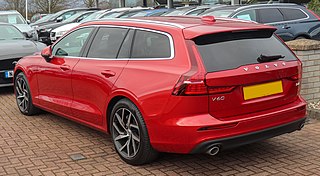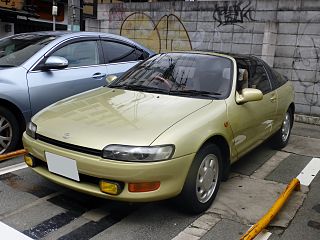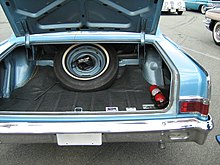
Minivan is a car classification for vehicles designed to transport passengers in the rear seating row(s), with reconfigurable seats in two or three rows. The equivalent classification in Europe is MPV.

A pickup truck or pickup is a light-duty truck that has an enclosed cabin, and a back end made up of a cargo bed that is enclosed by three low walls with no roof. In Australia and New Zealand, both pickups and coupé utilities are called utes, short for utility vehicle. In South Africa, people of all language groups use the term bakkie, a diminutive of bak, Afrikaans for "basket".

A van is a type of road vehicle used for transporting goods or people. Depending on the type of van, it can be bigger or smaller than a pickup truck and SUV, and bigger than a common car. There is some variation in the scope of the word across the different English-speaking countries. The smallest vans, microvans, are used for transporting either goods or people in tiny quantities. Mini MPVs, compact MPVs, and MPVs are all small vans usually used for transporting people in small quantities. Larger vans with passenger seats are used for institutional purposes, such as transporting students. Larger vans with only front seats are often used for business purposes, to carry goods and equipment. Specially equipped vans are used by television stations as mobile studios. Postal services and courier companies use large step vans to deliver packages.

A station wagon or estate car, is an automotive body-style variant of a sedan/saloon with its roof extended rearward over a shared passenger/cargo volume with access at the back via a third or fifth door, instead of a trunk/boot lid. The body style transforms a standard three-box design into a two-box design—to include an A, B, and C-pillar, as well as a D-pillar. Station wagons can flexibly reconfigure their interior volume via fold-down rear seats to prioritize either passenger or cargo volume.

A hatchback is a car body configuration with a rear door that swings upward to provide access to the main interior of the car as a cargo area rather than just to a separated trunk. Hatchbacks may feature fold-down second-row seating, where the interior can be reconfigured to prioritize passenger or cargo volume.

A sedan or saloon is a passenger car in a three-box configuration with separate compartments for an engine, passengers, and cargo. The first recorded use of sedan in reference to an automobile body occurred in 1912. The name derives from the 17th-century litter known as a sedan chair, a one-person enclosed box with windows and carried by porters. Variations of the sedan style include the close-coupled sedan, club sedan, convertible sedan, fastback sedan, hardtop sedan, notchback sedan, and sedanet/sedanette.

A utility vehicle (UV) is a vehicle, generally motorized, that is designed to carry out a specific task with more efficacy than a passenger vehicle. It sometimes refers to a small truck with low sides.
There are many types of car body styles. They vary depending on intended use, market position, location, and the era they were made in.

A trunk, also known as a travel trunk, is a large cuboid container designed to hold clothes and other personal belongings. They are most commonly used for extended periods away from home, such as for boarding school, or long trips abroad. Trunks are differentiated from chests by their more rugged construction due to their intended use as luggage, instead of the latter's pure storage.

A liftback is a variation of a hatchback with a sloping roofline between 45 and 5 degrees. Traditional hatchback designs usually have a 90 to 46 degree slope on the tailgate or rear door. As such the liftback is essentially a hatchback with a more sloping roof, similar to sedans/saloons from a styling perspective. Some liftbacks may also have an appearance similar to a coupe but with a tailgate hinged at the roof that is lifted to open.

The Nissan Prairie is an automobile manufactured and marketed by Nissan from 1981 to 2004. Considered a mini MPV or a compact MPV. It was also marketed as the Multi in Canada and the Stanza Wagon in the United States. In Japan, it was exclusive to Nissan Bluebird Store locations, then later at Nissan Blue Stage sales channels. The Prairie had a very flexible seating capability and sliding rear doors on both sides of the vehicle, with a liftgate in the back. The name "prairie" was derived from French which means an extensive area of relatively flat grassland, similar to "steppe" or "savanna".

The Toyota Sera is a 3-door 2+2 hatchback coupe manufactured and marketed by Toyota from 1990 to 1996. It was only officially sold in Japan.

The Austin A40 Farina is a small, economy car introduced by Austin in saloon (1958) and A40 Countryman (1959) estate versions. It has a two-box body configuration. It was badged, like many before it, as an A40, consistent with Austin's naming scheme at the time, based on the approximate engine output in horsepower; and to distinguish it from other A40 models, it was also given a suffix name – this one being the Farina, reflecting the all-new design by Italian Battista Farina's Pinin Farina Turin studio.

ZAZ Tavria is a range of front-wheel-drive subcompact cars produced by the Soviet and then Ukrainian manufacturer ZAZ.
A glossary of terms relating to automotive design.

The configuration of a car body is typically determined by the layout of the engine, passenger and luggage compartments, which can be shared or separately articulated. A key design feature is the car's roof-supporting pillars, designated from front to rear of the car as A-pillar, B-pillar, C-pillar and D-pillar.

A continental tire or a continental kit is a term used in the United States for an upright externally-mounted spare tire located behind an automobile's trunk, made popular by the Continental Mark Series, which carried a simulated continental tire until 1998.

A car door is a type of door opening, typically hinged on its front edge, but sometimes attached by other mechanisms such as tracks, for entering and exiting a vehicle. Doors most often integrate side windows for visibility from inside the car and can be locked to secure the vehicle.
A cargo barrier is a vehicle accessory installed into motor vehicles to aid occupancy safety when carrying loads or domestic pets, in the rear section of a vehicle. Other terms used for cargo barriers include: dog guard, mesh partition, load separator, pet barrier, and mesh grille.

The Honda N-Van is a microvan produced by Honda for the Japanese market. The origin for the vehicle's name expresses "next generation light van" proposed by N series as see in the N-One, N-Box, and N-WGN: it is part of a renewed lineup of Kei class city cars. The use of the letter "N" in the name was used by Honda for the late 1960s and 1970s Honda N360.
























